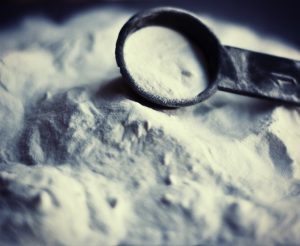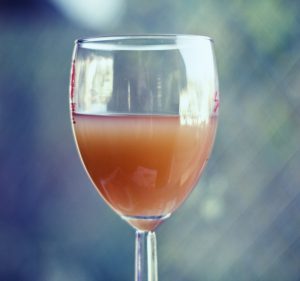crunched by Crunchy Betty
From now on, when we have a beauty issue, we’ll look in the cabinets – first – before we run out and buy an expensive (or even bargain) product to fix us.
And, I know, I know … there’s just something a little bit comforting about picking up a bottle of FancySchmancy-Make-You-Fabulous Potion; there’s some weird satisfaction in forking over your hard-earned money to feel hot.
But there’s a new and better feeling from fixing it yourself — by rummaging through your kitchen. (Put down the donuts. They do not belong on your hair.)
And don’t get me wrong, sometimes it’s easier or less time consuming to snag a product from the shelf. I’m just saying, kitchen first. Store second.
Now, I’m here to get you started with your tresses.
When I say “5 Foods You Have In Your Kitchen,” I mean “5 Foods That Are Still Left In My Kitchen,” because my produce drawer is really bare right now. I’ve had a hard time buying fruits and veggies since my week-long farmers market escapade a while back (that involved things like pumpkins). My burn-out is almost over, though. More fresh food beauty coming soon … I promise.
At this point, I figure if I have these 5 things in my kitchen, you SURELY have them in yours.
And we’re going to fix your hair. Today. Right now. And forever.
Amen.
1. Baking Soda
Do you have any idea how many times, on this blog, I have typed the words “baking soda?” Me either. But it has probably surpassed the number of beers Fiance’s friend James has drank while playing Rock Band. Why SO many times?
Because:
Baking
soda
kicks
butt.
Rinse Your Hair With Baking Soda Once a Week to Remove Build-Up
You can actually do this one of two ways: Add 2 Tbsp of baking soda to 3 cups of water. After shampooing, rinse with the baking soda water and then condition as you normally do. Or, if you have a way to keep your baking soda dry as you shower, put your shampoo in your hand (as usual) and then sprinkle a decent amount of baking soda on top of that. Then just wash your hair.
The baking soda will REALLY help clarify your hair and leave it shiny and silky – kinda like it’s brand new.
Who Should Use This: It’s okay for any hair type (especially if you only do it once a week), but it’s best served for people who have issues with hard water or product build-up, dull hair, or hair that just hangs out and doesn’t have much life to it. Like Fiance’s friend James.
.
2. Eggs
Why did the girl with dry hair cross the road?
To follow the chicken laying the eggs. (Who sawthat coming?)
You know those fancy shampoos you buy that run around with sparkly labels boasting “protein for strengthening” in them? Well, you can get the same effect just by washing your hair with eggs. And egg yolks are nice and packed with vitamins A, D, and E – all great for shiny, healthy hair. To top it off, the fatty acids in eggs moisturize and condition like nothing else.
How to Use Eggs in Haircare
Much like the baking soda above, the quickest and easiest way to get the great egg effect for your hair is to add a beaten egg to your regular shampoo. Just whip up the egg and pour some shampoo in the bowl with it. Wash your hair as normal.
Alternatively, you could whip up one or two eggs (depending on your volume of hair) and rub them into dry hair. Cover with a towel or shower cap and leave on 15 minutes before washing out. And please heed the note below.
Note of Caution: As the lovely Miss Stephanie pointed out a few months ago, if you’re not careful with your eggs in the shower, you could end up with scrambled hair. Make sure the water you rinse with isn’t so hot as to cook the eggs. THAT would be a mess.
Who Should Use This: People who have brittle or delicate hair – or anyone just wanting to add luster, strengthening, and moisture.
.
3. Molasses or Maple Syrup
A few weeks ago, one of my beautiful friends barreled up to me sputtering, “Maple syrup. My hair. Maple syrup. My hair!”
I was ready to dial 911. Isn’t that a sign of a seizure? Anyway, what she was really saying is that for years she’d had dry, unmanageable hair – and then she did a maple syrup pack, and it was, almost instantly, moisturized again.
Molasses works in much the same way (and I personally prefer it, because I have a molasses-scent fetish).
But the author of The Beauty Cookbook, Kym Douglas, infamously poured maple syrup on her hair on the Ellen Show(which happens to be where my friend got the idea), which gave rise to this now-standard beauty trick.
How to Use Molasses or Maple Syrup on Your Hair
Pour either of these things (you can dilute the molasses with water if it’s too thick to scrub in) on dry hair. Wrap with plastic wrap or cover with a good shower cap. Leave on for 20 minutes. Wash as you normally do. Note: Please use real maple syrup or molasses – none of this “mostly high-fructose corn syrup” crud. That’s not going to help much.
Who Should Use This: People with dry hair or anyone who wants a very hearty boost of moisturizing.
Bonus: Black strap molasses, taken internally (about 2 tsp a day) can help clear up acne and strengthen hair and nails. In fact, a couple of studies have shown that daily ingestion of black strap molasses may, in fact, help alleviate hair loss and even restore hair.
.
4. Apple Cider Vinegar
If there’s one thing I do for my hair on a regular basis, it’s use a diluted apple cider vinegar rinse at the end.
It may smell a little funky at first, but the vinegar scent dissipates as the hair dries, and leaves behind a VERY pH balanced scalp, which equals a really healthy head of hair.
As a side note, I’ve also been taking 2 tsp of apple cider vinegar in a glass of water once a day for about three weeks. Energy level has DEFINITELY gone up, and my occasional heartburn has completely disappeared.
I. Love. ACV.
How to Use Apple Cider Vinegar on Your Hair
Add 1 Tbsp of apple cider vinegar to 2 cups of water. Shake well.
After using conditioner, just before hopping out of the shower, rinse your hair with the ACV mixture. You can either do one last rinse with water, or leave it in. As I said, the scent will disappear completely as it dries.
Take your vinegar rinse up a notch by boiling chamomile (for blonde hair), rosemary (for dark hair) or nettle (any hair color) in the water before adding the apple cider vinegar. (Just be sure to strain the herbs out before adding ACV.)
Who Should Use This: Anyone who wants a little extra clarifying or suffers from dandruff, oily scalp, or dullness. In addition, anyone who wants a little extra smoothing shine should try an ACV rinse.
.
5. Olive Oil
Shoot. Who doesn’t want softer, shinier hair?
In the list of foods in your kitchen that work on your hair, olive oil probably takes the cake. It’s a centuries-old remedy that has been largely forgotten – and needs to be revived. Right now. Just like your hair.
There are a couple of ways you can use olive oil to moisturize and repair your locks – and I’m about to give you both of them.
Try it. Tell me how much you love it.
Then tell everyone else you know.
How to Use Olive Oil on Your Hair
To moisturize and strengthen: Pop 1/2 cup of olive oil in the microwave for 15 seconds (or heat on very low for a few minutes) – just until it’s warm enough to matter, but not so hot that it burns your skin. Apply to damp (not dripping!) hair. Wrap with plastic wrap or cover with a warm towel. Leave this on for 20 minutes to an hour, and then shampoo out as usual.
To smooth and shine: Put a scant 1/2 tsp of olive oil in your palms and rub. Then apply to the top of your hair, moving downward.
Who Should Use This: Everyone! Olive oil is great for any hair type and helps with pretty much any issue you may have. If you have a lot of flyaways or split ends, the “smooth and shine” method willfix it like you wouldn’t believe.






No comments:
Post a Comment